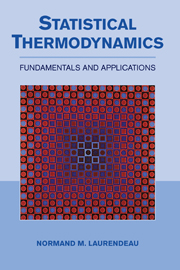Book contents
- Frontmatter
- Contents
- Preface
- 1 Introduction
- PART ONE FUNDAMENTALS OF STATISTICAL THERMODYNAMICS
- PART TWO QUANTUM MECHANICS AND SPECTROSCOPY
- PART THREE STATISTICAL THERMODYNAMICS IN THE DILUTE LIMIT
- PART FOUR STATISTICAL THERMODYNAMICS BEYOND THE DILUTE LIMIT
- PART FIVE NONEQUILIBRIUM STATISTICAL THERMODYNAMICS
- PART SIX THE ENSEMBLE METHOD OF STATISTICAL THERMODYNAMICS
- 18 The Canonical and Grand Canonical Ensembles
- 19 Applications of Ensemble Theory to Real Gases
- Problem Set VIII Ensemble Theory and the Nonideal Gas (Chapters 18–19)
- 20 Whence and Whither
- PART SEVEN APPENDICES
- Index
19 - Applications of Ensemble Theory to Real Gases
Published online by Cambridge University Press: 05 June 2012
- Frontmatter
- Contents
- Preface
- 1 Introduction
- PART ONE FUNDAMENTALS OF STATISTICAL THERMODYNAMICS
- PART TWO QUANTUM MECHANICS AND SPECTROSCOPY
- PART THREE STATISTICAL THERMODYNAMICS IN THE DILUTE LIMIT
- PART FOUR STATISTICAL THERMODYNAMICS BEYOND THE DILUTE LIMIT
- PART FIVE NONEQUILIBRIUM STATISTICAL THERMODYNAMICS
- PART SIX THE ENSEMBLE METHOD OF STATISTICAL THERMODYNAMICS
- 18 The Canonical and Grand Canonical Ensembles
- 19 Applications of Ensemble Theory to Real Gases
- Problem Set VIII Ensemble Theory and the Nonideal Gas (Chapters 18–19)
- 20 Whence and Whither
- PART SEVEN APPENDICES
- Index
Summary
As indicated in Chapter 18, ensemble theory is especially germane when calculating thermodynamic properties for systems composed of dependent rather than independent particles. Potential applications include real gases, liquids, and polymers. In this chapter, we focus on the thermodynamic properties of nonideal gases. Our overall approach is to develop an equation of state using the grand canonical ensemble. From classical thermodynamics, equilibrium properties can always be determined by suitably operating on such equations of state. As shown later in this chapter, typical evaluations require an accurate model for the intermolecular forces underlying any macroscopic assembly. This requirement is endemic to all applications of ensemble theory, including those for liquids and polymers. As a matter of fact, by mastering the upcoming procedures necessary for the statistics of real gases, you should be prepared for many pertinent applications to other tightly-coupled thermodynamic systems.
The Behavior of Real Gases
As the density of a gas rises, its constituent particles interact more vigorously so that their characteristic intermolecular potential exercises a greater influence on macroscopic behavior. Accordingly, the gas becomes less ideal and more real; i.e., its particles eventually display greater contingency owing to enhanced intermolecular forces. This deviation from ideal behavior is reflected through a more complicated equation of state for real gases.
An equation of state, you recall, describes a functional relation among the pressure, specific volume, and temperature of a given substance.
- Type
- Chapter
- Information
- Statistical ThermodynamicsFundamentals and Applications, pp. 359 - 374Publisher: Cambridge University PressPrint publication year: 2005



